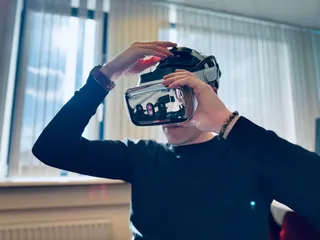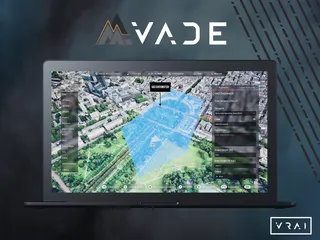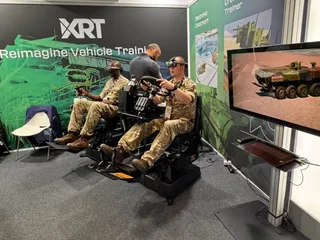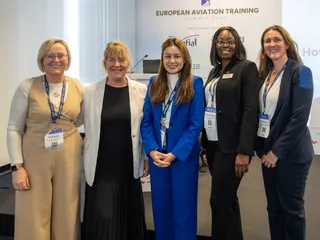Tech Deep Dive: Digital Twin. Are We There Yet?
Contact Our Team
For more information about how Halldale can add value to your marketing and promotional campaigns or to discuss event exhibitor and sponsorship opportunities, contact our team to find out more
The Americas -
holly.foster@halldale.com
Rest of World -
jeremy@halldale.com

This is another in a series of articles exploring the digital twin in safety critical industry training programs. The most recent piece focused on the commercial maritime sector.
An expanding number of safety critical training enterprises beyond commercial maritime are using digital twin in their instructional strategies. The digital twin’s technology underpinnings continue to mature and evolve. At the same time, the providers of learning products with this enabler and their customers report attention-getting ROIs on their simulation and training investments.
Here's an appropriate question to ask on this point of digital twin’s journey: are we there yet in terms of this enabler meeting the training enterprises’ full expectations for ROIs and other outcomes?
The Role of Digital Twin Technology
Leaders at two, disparate S&T companies provided insights for this article.
One sector member, Toronto-based VR Vision, is committed to transforming individual and workforce training across safety-critical industries. As Co-Founder and COO Lorne Fade explained when he spoke with the author this 16 July, the company helps workers master complex, high-risk tasks using immersive technologies. VR Vision is active in energy (including oil, gas, and renewables), utilities, manufacturing, warehousing, construction, and crane operations.
Fade noted early in the conversation that digital twin technology is just one component of VR Vision’s broader instructional design framework. Their training solutions integrate a range of immersive technologies, with digital twins playing a key role in replicating real-world environments.
To illustrate, Fade referenced their white paper, What Does VR Training Actually Cost? A Clear-Cut Guide to Your Investment. The document outlines, in part, how digital assets are created in VR: “Digital Asset Creation in Virtual Reality Development can be approached through 360 Video or 3D models (digital twin creation).” These assets are then enhanced by interactions, user interfaces, localization and sound design.
“Our specialty is digital twins,” Fade explained. “We visit client sites, capture video and photos of real-world equipment and processes, and turn those into base 3D ‘gray boxes’ for modeling. From there, we texture and refine the assets until they closely match the real environment.”
He emphasized the importance of realism: “We aim to create a 1:1 replica of the real world so that when learners transition from VR to the actual task, it feels familiar. In many cases, they’re already up to speed before they even touch the real equipment.”
This 18 July, Jan Luc Zandjans, Founder at Steel Sim VR, said, “Digital twin is a broad term that varies widely across industries, from engineering-grade monitoring tools to lifecycle planning systems and AI-driven process models. At Steel Sim VR, our lens is focused on how digital twins can improve human performance through XR-enabled, hands-on learning.”
Steel Sim VR specializes in immersive crane training for the global steel sector. The company’s simulators are currently in use at several high-risk steel production sites where traditional training methods would expose operators to considerable danger or downtime. “You’ll find our systems operating at Tata Steel IJmuiden and Port Talbot, ArcelorMittal Gent, Bremen and Eisenhüttenstadt, EMSTEEL in the United Arab Emirates, and Algoma Steel in Canada,” the executive said and emphasized these are environments where operators handle heavy loads in complex, high-risk production areas. On cue, the corporate leader added, “Our simulators offer a safe, data-rich training alternative that prepares operators for those exact conditions.”
Netherlands-based Steel Sim VR’s “secret sauce” in its training solutions includes digital twin technology to create highly accurate virtual replicas of both cranes and their working environments, including real-world controls, physics, emergency procedures and plant-specific workflows. The corporate leader said these aren’t just visual representations, but full-behavior simulations. “Operators can experience how a crane reacts to load swing, inertia, or control missteps, exactly as they would on the shop floor.”
Steel Sim VR develops the digital twins in close collaboration with each client. “We collect CAD models, control system specs, and safety protocols, and use those to build immersive environments that reflect operational reality as precisely as possible. It’s a rigorous process, but the payoff in operator readiness and risk reduction is substantial.”
Zandjans commented a bit more on his business model, which mirrors another S&T industry trend – to develop and deliver a digital twin with internal resources. The corporate leader recalled digital twin technology, including its real-time simulation engine, training scenarios, user interfaces, and analytics dashboards, is developed in-house by the company team. “We work closely with partners on the development of our proprietary Steel Sim VR physics engine and the creation of highly detailed, site-specific digital replicas of crane systems and plant environments. While technical data and operational expertise come from our clients and partners, the software architecture, behavioral modeling, and implementation are all integrated and maintained by our internal development team. This approach ensures a seamless alignment between hardware fidelity, simulation accuracy, and the specific training objectives of each customer.”
VR as a Strategic Supplement and ROIs
Digital twins are just one part of a holistic VR learning strategy. Fade emphasized that while the industry is seeing increased adoption of VR, a “killer use case” is still lacking for mass uptake. “The hype has died down. AI is taking the spotlight now. But VR remains extremely effective when implemented correctly—especially when it comes to ROI through error reduction, shortened travel time, and consistent knowledge transfer.”
The leader shared success stories, ROIs, including how VR Vision helped Toyota and Avangrid reduce travel costs by enabling employees to train remotely. “They’re saving millions of dollars annually. Trainees just plug in and go—wherever they are. And thanks to our Vision Portal, instructors can join live multiplayer sessions, guide learners, and monitor analytics in real time.”
Steel Sim VR also reported impressive ROIs from its digital twin-based products.
In one case, at ArcelorMittal Gent, the S&T company “documented a 90% reduction in damage during training, a 25% drop in time spent onboarding in the production environment, and a significant decrease in mentor hours per trainee. The ability to simulate rare or dangerous scenarios, without risk or cost, adds long-term value in both performance and safety.”
VR Vision’s Fade concluded: “We don’t see VR as a replacement for traditional training. It’s a powerful supplement that enhances existing programs. That’s where VR Vision has found success.”
Bridging the Digital Twin Gap and the Road Ahead
A persistent theme in this author’s discussions with S&T community professionals is their continued, incremental success in bridging the gaps in fidelity and other digital twin attributes.
On the hardware front, VR Vision’s Fade said, “Graphics have come a long way. When we started eight years ago, the first Oculus headsets had limited fidelity. Now, with the Quest 3S, each generation doubles visual quality. We're approaching true 1:1 replication.”
So, what’s still missing? “Haptic feedback,” Fade said. While there are some experimental tools on the market—such as shock vests for electrical training—these are still gimmicks. “Nothing truly replicates real-world physical feedback just yet.”
On the software side, Fade sees three key advancements on the horizon:
- AI integration for procedural adaptation and learner personalization.
- IoT-linked twins for predictive maintenance and real-time updates.
- Web/XR interoperability for easier access and cross-platform use.
VR Vision is actively investing in all three areas.
Steel Sim VR’s Zandjans offered that “definitely the next step” in the evolution of digital twin, is a clear shift from static models to dynamic, learning-driven environments. “Digital twins will become more intelligent, capable of adapting to trainee behavior and offering personalized coaching based on real-time data. We also anticipate growth in multi-user training environments, where crane operators can coordinate virtually with spotters, truck drivers or team leads, replicating real operational complexity.” The executive added one area Steel Sim VR is particularly excited about is the use of the simulator as a testbed for future production environments. He explained that clients are already using Steel Sim VR to test crane movement paths, equipment layouts and interaction with installations before a facility is built. “This reduces commissioning risks and helps design smarter, safer operations from the start.”
On our Editorial Watch List
Digital twin has gained traction as an underpinning for XR-supported learning across safety critical industries’ learning programs, with ROIs to validate its value proposition. Advancements in digital twin’s hardware and software foundations are moving S&T industry suppliers and their customers closer to declaring they “are there” in terms of fidelity and other attributes to meet end user requirements. Halldale Group will be following these stakeholders on their journey.


